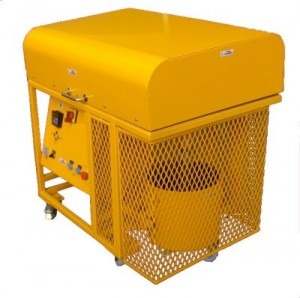
The Controlled Two Point Test (CTPT), available from Aptifirst, is used to determine the rheology of wet cement and concrete pastes.
According to the company, the flow properties of wet cements and concrete are important in determining how the mortars and pastes will behave as they are being poured and worked and how they will wet rebar-reinforcing rods, aggregate and substrates.
These flow properties are referred to as 'workability' and are traditionally assessed using the Slump Test, which uses a truncated steel cone, of standard (BS EN 12350-2) dimensions, with open ends into which the test material is packed.
The steel cone is then removed and the amount by which the mixture sags or slumps is measured.
The Slump Test is claimed to be rapid, easy to use and inexpensive.
However, it gives qualitative results rather than useful engineering data about the mix.
The study of flow behaviour is known as rheology, and much work has been done in the laboratory to characterise a range of materials using instruments such as cone-and-plate and capillary extrusion rheometers.
However, the multi-phase, granular nature of cement and concrete pastes precludes them from analysis on most instruments.
In the 1970-80s, Dr Geoff Tattersall of Sheffield University's Concrete Research Centre set out to characterise the rheology of wet cement and concrete pastes and to design a machine to test them.
He discovered that the materials generally would not flow before a characteristic yield stress was exceeded, and then flowed in a linear manner - the shear stress force increased proportionally to the shear rate speed of deformation.
Such materials are known as Bingham Bodies.
Tattersall realised he could characterise the materials by two points, namely the yield stress and the slope of the line on the plot of shear stress versus shear rate, hence the Two Point Test.
He designed his machine to do just that; a helical impeller was immersed in a sample of the material and was driven by a gearbox and motor system at each of two pre-selected speeds, and the resulting torque at each speed was noted.
The CTPT instrument has been refined over the years, and the latest version is available from Aptifirst.
It uses a servo-drive system to give precise control of impeller speed, uses a strain-gauge-based torque transducer to measure the torque and is computer controlled via a PC and a purpose-written software application so that speed profiles such as ramps and 'staircases', as well as constant speeds, may be run.
It uses a stainless steel helical impeller as standard, although a planetary gearing system with H-impellers is available for stiffer mixes.
The machine will take base lines into account, allow transducer calibration and calculate the two points needed to characterise the mix, as well as storing the data in an easily accessible CSV format.




